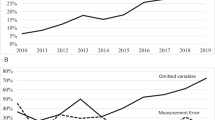Abstract
Let u ≥ 0 be technical inefficiency, let z be a set of variables that affect u, and let δ be the parameters of this relationship. The model satisfies the scaling property if u(z, δ) can be written as a scaling function h(z, δ) times a random variable u* that does not depend on z. This property implies that changes in z affect the scale but not the shape of u(z,δ). This paper reviews the existing literature and identifies models that do and do not have the scaling property. It also discusses practical advantages of the scaling property. The paper shows how to test the hypothesis of scaling, and other interesting hypotheses, in the context of the model of Wang, Journal of Productivity Analysis, 2002. Finally, two empirical examples are given.
Similar content being viewed by others
References
DJ Aigner CAK Lovell P Schmidt (1977) ArticleTitleand estimation of stochastic frontier production functions J. Econometrics 6 21–37 Occurrence Handle10.1016/0304-4076(77)90052-5
GE Battese TJ Coelli (1992) ArticleTitleFrontier production functions, technical efficiency and panel data: with applications to paddy farmers in India J Prod Anal 3 153–169 Occurrence Handle10.1007/BF00158774
GE Battese TJ Coelli (1995) ArticleTitleA model for technical inefficiency effects in a stochastic frontier production function for panel data Empirical Econ 20 325–332 Occurrence Handle10.1007/BF01205442
SB Caudill JM Ford (1993) ArticleTitleBiases in frontier estimation due to heteroskedasticity Econ Lett 41 17–20 Occurrence Handle10.1016/0165-1765(93)90104-K
SB Caudill JM Ford DM Gropper (1995) ArticleTitleFrontier estimation and firm-specific inefficiency measures in the presence of heteroskedasticity J Bus Econ Stat 13 105–111 Occurrence Handle10.2307/1392525
RA Cuesta L Orea (2002) ArticleTitleMergers and technical efficiency in Spanish savings banks: A stochastic distance function approach J Bank Finance 26 2231–2247 Occurrence Handle10.1016/S0378-4266(01)00184-4
C Han L Orea P Schmidt (2005) ArticleTitleEstimation of a panel data model with parametric temporal variation in individual effects J Econometrics 126 241–267 Occurrence Handle10.1016/j.jeconom.2004.05.002
BE Hansen (1996) ArticleTitleInference when a nuisance parameter is not identified under the null hypothesis Econometrica 64 413–430
F Hayashi (2000) Econometrics Princeton University Press Princeton
CJ Huang J-T Liu (1994) ArticleTitleEstimation of a non-neutral stochastic frontier production function J Prod Ana 5 171–180 Occurrence Handle10.1007/BF01073853
SC Kumbhakar (1990) ArticleTitleProduction frontiers, panel data, and time-varying technical efficiency J Econometrics 46 201–211 Occurrence Handle10.1016/0304-4076(90)90055-X
SC Kumbhakar S Ghosh JT McGuckin (1991) ArticleTitleA generalized production frontier approach for estimating determinants of inefficiency in US dairy farms J Bus Econ Stat 9 279–286 Occurrence Handle10.2307/1391292
SC Kumbhakar CAK Lovell (2000) Stochastic frontier analysis Cambridge University Press Cambridge
D Reifschneider R Stevenson (1991) ArticleTitleSystematic departures from the frontier: A framework for the analysis of firm inefficiency Int Econ Rev 32 715–723
Simar L, Lovell CAK, van den Eeckaut P (1994) Stochastic frontiers incorporating exogenous influences on efficiency. Discussion paper no. 9403, Institut de Statistique, Université Catholique de Louvain.
Simar L, Wilson P (2003) Estimation and inference in two-stage, semi-parametric models of production processes. discussion paper no. 0307, Institut de Statistique, Université Catholique de Louvain.
RE Stevenson (1980) ArticleTitleLikelihood functions for generalized stochastic frontier estimation J Econometrics 13 57–66 Occurrence Handle10.1016/0304-4076(80)90042-1
H-J Wang (2002) ArticleTitleHeteroscedasticity and non-monotonic efficiency effects of a stochastic frontier model J Prod Anal 18 241–253 Occurrence Handle10.1023/A:1020638827640
H-J Wang (2003) ArticleTitleA stochastic frontier analysis of financing constraints on investment: the case of financial liberalization in Taiwan J Bus Econ Stat 21 406–419 Occurrence Handle10.1198/073500103288619016
H-J Wang P. Schmidt (2002) ArticleTitleOne-step and two-step estimation of the effects of exogenous variables on technical efficiency levels J Prod Anal 18 129–144 Occurrence Handle10.1023/A:1016565719882
Author information
Authors and Affiliations
Corresponding author
Rights and permissions
About this article
Cite this article
Alvarez, A., Amsler, C., Orea, L. et al. Interpreting and Testing the Scaling Property in Models where Inefficiency Depends on Firm Characteristics. J Prod Anal 25, 201–212 (2006). https://doi.org/10.1007/s11123-006-7639-3
Issue Date:
DOI: https://doi.org/10.1007/s11123-006-7639-3




